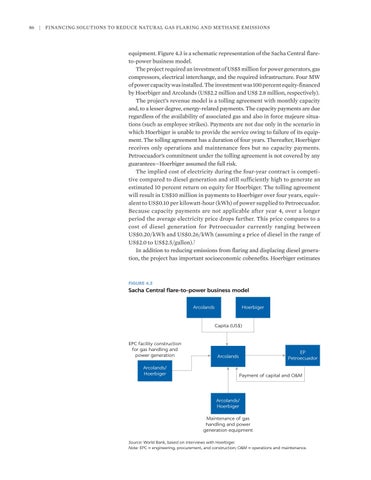86
| Financing Solutions to Reduce Natural Gas Flaring and Methane Emissions
equipment. Figure 4.3 is a schematic representation of the Sacha Central flareto-power business model. The project required an investment of US$5 million for power generators, gas compressors, electrical interchange, and the required infrastructure. Four MW of power capacity was installed. The investment was 100 percent equity-financed by Hoerbiger and Arcolands (US$2.2 million and US$ 2.8 million, respectively). The project’s revenue model is a tolling agreement with monthly capacity and, to a lesser degree, energy-related payments. The capacity payments are due regardless of the availability of associated gas and also in force majeure situations (such as employee strikes). Payments are not due only in the scenario in which Hoerbiger is unable to provide the service owing to failure of its equipment. The tolling agreement has a duration of four years. Thereafter, Hoerbiger receives only operations and maintenance fees but no capacity payments. Petroecuador’s commitment under the tolling agreement is not covered by any guarantees—Hoerbiger assumed the full risk. The implied cost of electricity during the four-year contract is competitive compared to diesel generation and still sufficiently high to generate an estimated 10 percent return on equity for Hoerbiger. The tolling agreement will result in US$10 million in payments to Hoerbiger over four years, equivalent to US$0.10 per kilowatt-hour (kWh) of power supplied to Petroecuador. Because capacity payments are not applicable after year 4, over a longer period the average electricity price drops further. This price compares to a cost of diesel generation for Petroecuador currently ranging between US$0.20/kWh and US$0.26/kWh (assuming a price of diesel in the range of US$2.0 to US$2.5/gallon).7 In addition to reducing emissions from flaring and displacing diesel generation, the project has important socioeconomic cobenefits. Hoerbiger estimates
FIGURE 4.3
Sacha Central flare-to-power business model Arcolands
Hoerbiger
Capita (US$)
EPC facility construction for gas handling and power generation Arcolands/ Hoerbiger
EP Petroecuador
Arcolands
Payment of capital and O&M
Arcolands/ Hoerbiger Maintenance of gas handling and power generation equipment Source: World Bank, based on interviews with Hoerbiger. Note: EPC = engineering, procurement, and construction; O&M = operations and maintenance.
